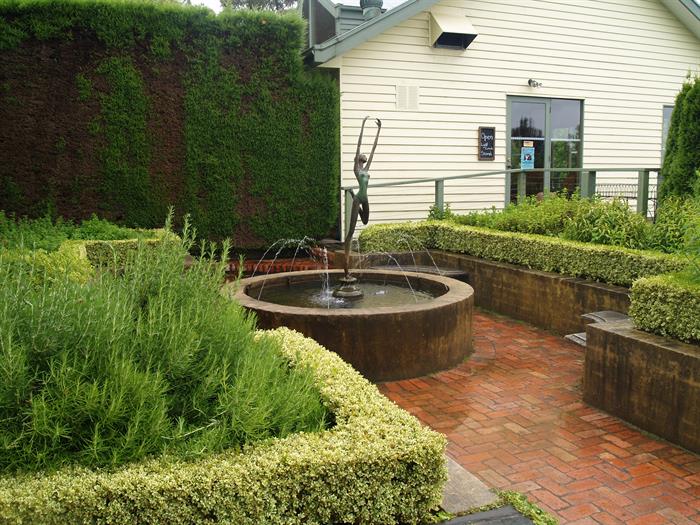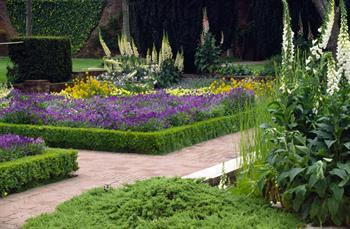Hedges
If you’re looking for a cheap alternative to a wall or fence, consider growing a hedge. You will need to be patient – a dense hedge may take several years to establish, but the results are certainly worth the wait. Like a wall or fence, a hedge defines property and garden boundaries, and provides privacy, shelter and a sense of enclosure. They can be high, to create an enclosed garden room, or low to define a garden border. Hedges can also be used to provide security for a property, particularly if they include plants with thorns.

Preparing the Site
The secret to a successful hedge is correct soil preparation. Once you have decided where you want to grow your hedge, set up a string line to mark the planting positions. Dig a trench along the entire length, and add well rotted organic matter to the soil. Leave for a month or so to allow the soil to settle before planting.
Choosing your Plants
Only some types of plants are suitable for hedging. Some plants will not tolerate constant cutting, and others simply do not develop dense, even growth. The best hedging plants usually have small leaves, though for larger hedges, larger leaved plants may be acceptable.
If you are going to grow a large hedge, you will need a lot of plants, so more expensive, difficult-to-grow plants may be less desirable.
When you choose the plants, consider the following:
-
Do you want an evergreen or deciduous hedge?
-
Do you prefer an informal or formal hedge? Formal hedges need to be clipped frequently so choose a species that will tolerate frequent cutting.
-
How high do you want the hedge? Consider the plants’ natural size at maturity – if you want a 1 m high hedge, don’t choose plants which naturally grow to 3 or 4 m.
-
How dense? A more open hedge will give better air circulation but less privacy.
-
What size plants are you going to buy? Advanced plants can be very expensive but will give an almost instant effect. Smaller plants are cheaper and often give better results in the long run.
-
Do you want a quick effect? Many fast-growing plants will rapidly develop into a dense hedge but will require frequent clipping to maintain a tidy shape. Some may also be short-lived.
Selected Plants Suitable for Hedging (in temperate areas)
Abelia
1.5-2.5m tall. Evergreen; glossy green-bronze foliage and white flowers; informal hedge.
Buxus
0.5 – 2 m tall. Evergreen; tight green leaves; forms a formal hedge; requires frequent clipping.
Callistemon
2-4m tall. Evergreen; Australian native; forms an open informal hedge.
Camellia Sasanqua
2-3 m tall. Evergreen; glossy leaves and beautiful autumn flowers; informal hedge.
Conifers
Come in a variety of sizes from small shrubs to tall trees. Many can be pruned to make effective hedges.
Craetaegus (Hawthorn)
2-4 m tall. Deciduous; thorny branches; spring flowers and autumn fruit; informal hedge for cooler areas.
Lavender
1m tall. Evergreen; silvery-green foliage and blue flowers. Scented plant, formal or informal hedge.
Lonicera Nitida
0.5-1.5m tall. Evergreen; small leaves. For formal hedges.
Euonymus
1 – 2m tall. Evergreen; variagated foliage. Coloured plants suited to formal or informal hedging if pruned regularly.
Syzygium
1 – 3m tall. Evergreen. Australian lillypillies with a lot of variation in foliage and habit - new flushes tend to be red or pink. White flowers and coloured berries.
Selected Plants Suitable for Hedging (in Tropics and Sub Tropics)
Alternanthera
0.2 – 0.5m tall. Evergreen; deep red foliage plant with small white flowers, popular when hedged near golden/yellow plants.
Cuphea
0.1 – 0.3m tall. Evergreen; small petite leaves and small coloured flowers, excellent for formal hedges.
Duranta
1 – 2m tall. Evergreen; green or golden forms available, with white or blue flowers. A very popular hedge.
Murraya
1 – 2m tall. Evergreen; glossy green leaves and white scented flowers, for formal and informal hedges. Strong scent is attractive to some but overpowering and undesirable to others.
Gardenia
0.5 – 1.5m tall. Evergreen; large glossy leaves and large scented white flowers in spring, informal hedge. Again the scent can be a problem to some.
Nerium Oleander
1 – 2m tall. Evergreen; long green leaves and coloured flowers make this a popular hedging plant in areas of low rainfall. All parts of this plant are poisonous. Informal hedge.
Plumbago
0.5 – 2.5m tall. Evergreen; light green leaves with white or blue flowers, informal hedge.
Syzygium
1 – 3m tall. Evergreen. Native lillypillies with a lot of variation in foliage and habit, new flushes tend to be red or pink. White flowers and coloured berries. Best suited to informal hedges.
How to Plant a Hedge
When you’re ready to plant, work out the spacing carefully because unevenly spaced plants will be very obvious and will spoil the effect. Remove the plants from their pots and tease out coiled roots. Backfill the soil so that the level is the same as it was in the pots. Water well, and cover with mulch.
At this stage, only prune to remove misshapen or broken branches.
How to Prune a Hedge
The secret to pruning a hedge is to gently taper the sides of the hedge so that the top is slightly narrow than the bottom. This will ensure that all parts of the hedge receive light and gaps will not develop at the base of the hedge.
-
New plants – start pruning as soon as the plants are established in the soil. Cut the top growth severely to encourage dense, low branching.
-
Conifers - don’t cut into old leafless growth.
-
Formal hedges – trim every few weeks during the growing season.
-
Informal hedges – trim once or twice annually.
-
For small hedges use secateurs or hedging shears
-
For larger hedges use electric clippers.
-
Keep tools sharp to make clean cuts and avoid disease.
In some situations it will not always be possible or practical to prune your own hedge. The hedge may be too high, or you may not have either the time or suitable tools to do the job. In this situation you should consider employing a professional hedge pruning specialist.

Maintaining a Hedge
The secret to avoiding gaps developing in your hedge is:
- Keep it properly pruned.
- Keep all the plants in a healthy condition – keep the plants well watered and fertilised.
- Use mulch to prevent weeds and to maintain soil moisture.
Would you like to learn more about hedging, plant growth, propagation, or garden design? ACS offer a great range of courses at different levels of study in these areas and more, including:
Foundation Certificate In Plant Growth For Horticulture Level 2
Plant Selection And Establishment
Perennials
Our wide range of online courses (over 700!), is complemented by a diverse range of eBooks, including:
Pruning
Growing And Knowing Lavender
Growing Conifers
In addition, we now offer a range of 20 hour Short Courses, including:
Pruning
[26/12/2025 23:31:34]